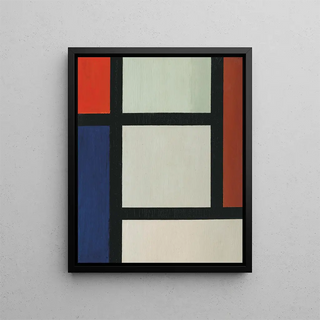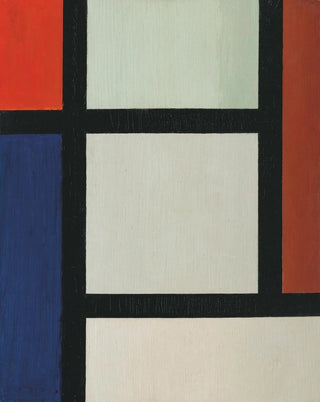Art print | Counter-Composition - Theo van Doesburg Source: Reproduction | Contre-Composition - Theo van Doesburg


View from behind

Frame (optional)
Reproduction Contre-Composition - Theo van Doesburg – Introduction captivante
The "Contre-Composition" by Theo van Doesburg is an iconic artwork that transcends the simple frame of art to establish itself within an avant-garde movement. Created in 1925, this piece embodies the principles of neoplasticism, an artistic movement he helped to found alongside Piet Mondrian. The dynamic between geometric shapes and primary colors creates a visual tension that captivates the viewer and invites deep reflection on harmony and imbalance. Contemplating this work transports one to a universe where abstraction becomes a language in its own right, a means of expressing complex ideas through simple visual elements.
Style and uniqueness of the work
The style of the "Contre-Composition" is distinguished by its bold use of lines and shapes. Van Doesburg plays with rectangles and squares, juxtaposing vivid colors and contrasting areas to create an effect of depth and movement. This stylistic choice reflects his desire to break away from the artistic conventions of his time, proposing a radically new vision of pictorial space. The colors, carefully selected, are not merely decorative elements; they carry emotional and symbolic weight that enriches the interpretation of the artwork. The asymmetrical aspect of the composition, far from being a flaw, is instead a celebration of dynamics and instability, themes dear to Van Doesburg.
The artist and his influence
Theo van Doesburg, a key figure of the 20th century, managed to mark his era with his innovative vision and commitment to modern art. As a theorist and practitioner, he not only produced significant works but also wrote numerous texts that shaped artistic thought. His influence extends well beyond his own work, inspiring generations of artists to explore the limits of abstraction. By integrating elements of architecture and design into his painting practice, he paved the way for an interdisciplinary approach that continues to resonate in contemporary art. The "Contre-Composition" thus reflects his ambition to create art that is both aesthetic and conceptual.

Matte finish

View from behind

Frame (optional)
Reproduction Contre-Composition - Theo van Doesburg – Introduction captivante
The "Contre-Composition" by Theo van Doesburg is an iconic artwork that transcends the simple frame of art to establish itself within an avant-garde movement. Created in 1925, this piece embodies the principles of neoplasticism, an artistic movement he helped to found alongside Piet Mondrian. The dynamic between geometric shapes and primary colors creates a visual tension that captivates the viewer and invites deep reflection on harmony and imbalance. Contemplating this work transports one to a universe where abstraction becomes a language in its own right, a means of expressing complex ideas through simple visual elements.
Style and uniqueness of the work
The style of the "Contre-Composition" is distinguished by its bold use of lines and shapes. Van Doesburg plays with rectangles and squares, juxtaposing vivid colors and contrasting areas to create an effect of depth and movement. This stylistic choice reflects his desire to break away from the artistic conventions of his time, proposing a radically new vision of pictorial space. The colors, carefully selected, are not merely decorative elements; they carry emotional and symbolic weight that enriches the interpretation of the artwork. The asymmetrical aspect of the composition, far from being a flaw, is instead a celebration of dynamics and instability, themes dear to Van Doesburg.
The artist and his influence
Theo van Doesburg, a key figure of the 20th century, managed to mark his era with his innovative vision and commitment to modern art. As a theorist and practitioner, he not only produced significant works but also wrote numerous texts that shaped artistic thought. His influence extends well beyond his own work, inspiring generations of artists to explore the limits of abstraction. By integrating elements of architecture and design into his painting practice, he paved the way for an interdisciplinary approach that continues to resonate in contemporary art. The "Contre-Composition" thus reflects his ambition to create art that is both aesthetic and conceptual.






